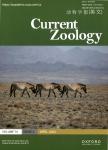Role of conspecifics and personal experience on behavioral avoidance of contaminated flowers by bumblebees
作者机构:lnstitut fur Biologie Molekulare Okologie Martin-Luther-Universitat Halle-Wittenberg Hoher Weg Halle (Saale) Germany Centre for Ecological and Evolutionary Synthesis (CEES) Department of Biosciences University of Oslo Oslo Norway Microbes and Pathogens Biology The Institute for Global Food Security School of Biological Sciences Queen's University Belfast United Kingdom lnternational Centre of Insect Physiology and Ecology (ICIPE) Nairobi Kenya German Centre for Integrative Biodiversity Research (iDiv) Halle-Jena-Leipzig Deutscher Platz Leipzig Germany
出 版 物:《Current Zoology》 (动物学报(英文版))
年 卷 期:2019年第65卷第4期
页 面:447-455页
核心收录:
学科分类:0710[理学-生物学] 07[理学] 0905[农学-畜牧学] 0906[农学-兽医学]
基 金:supported by Bundesministerium fur Bildung und Forschung (BMBF) (Federal Ministry of Education and Research, Germany) grant through support by the International Association for the Exchange of Students for Technical Experience (IAESTE) (to ER)
主 题:Host-parasite in teractions social learning pollinators inadvertent social information behavioral immunity copying behavior
摘 要:Pollinators use multiple cues whilst foraging in eluding direct cues from flowers and in direct cues from other pollinators. The use of indirect social cues is common in social in sects, such as honeybees and bumblebees, where a social environment facilitates the ability to use such cues. Bumblebees use cues to forage on flowers according to previous foraging experiences. Flowers are an essential food source for pollinators but also pose a high risk of parasite infection through the shared use of flowers leading to parasite spillover. Nevertheless, bumblebees have evolved behavioral defense mechanisms to limit parasite infection by avoiding contaminated flowers. Mechanisms underlying the avoidance of contaminated flowers by bumblebees are poorly understood. Bumblebees were recorded having the choice to forage on non-contaminated flowers and flowers contaminated by a trypan osome gut parasite, Crithidia bombi. The use of different treatments with presence or absence of con specifics on both con taminated and non-contami nated flowers allowed to investigate the role of social visual cues on their pathogen avoidance behavior. Bumblebees are expected to use social visual cues to avoid contaminated flowers. Our study reveals that the presence of a con specific on flowers either con taminated or not does not help bumblebee foragers avoiding contaminated flowers. Nevertheless, bumblebees whereas gaining experie nee tend to avoid their con specific when placed on contami nated flower and copy it whe n on the non-contami nated flower. Our experime nt suggests a detrime ntal impact of floral see nt on disease avoidanee behavior.



